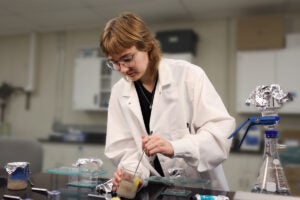
Nearly two year years ago, the Texas Advanced Computing Center (TACC) debuted its newly revamped Visualization Laboratory (Vislab).
Though primarily intended for scientific research, the Vislab has become a dramatic attraction for students, artists, humanities researchers and university officials, who frequently showcase the lab on VIP tours. From analysis of brain scans to student film festivals, the lab is now a hub for novel research and presentations across the sciences and humanities.
“We have been very pleased that we have seen users from lots of different scientific disciplines — as well as more non-traditional users out of the arts, humanities and social sciences — using the lab,” said Kelly Gaither, TACC’s director of the Visualization and Data Analysis group.
The Vislab houses several of the university’s most advanced and remarkable displays. These include: “Bronco,” the university’s most powerful video projector (the same used by the Alamo Drafthouse); “Mustang,” a 82″ 3-D TV (with 3-D glasses); and the “Stallion,” the highest-resolution tiled display in the world, a 75-monitor super-screen powered by a cluster of 23 compute nodes. Dell Inc. provided the computer systems and monitors for the lab, which together enable users to explore high-resolution images, stage dynamic presentations and collaborate on massive data analysis.
Innovative and creative uses of the Vislab

The ability to show many large, related images at one time can have dramatic results. This was the case for Marcus Gary, a recent Ph.D. graduate from the Jackson School of Geosciences, who used the Vislab to present his dissertation defense.
Using all the screens available in the lab, Gary displayed dozens of animations, visualizations, maps and photos simultaneously to evoke the maximum “wow-factor.”
“The impact was phenomenal,” Gary said. “Many of the scientists who attended said, ‘That was the most spectacular defense I’ve ever seen.'”
The technology allowed Gary to compress a tremendous amount of visual data into a short presentation, multiplying the amount of information conveyed.
_____________________________
Chandrajit Bajaj, Computational Applied Mathematics Chair in Visualization, understands the value of seeing science at the largest and smallest scales.

Bajaj, a professor of computer science and director of the Computational Visualization Center, uses the Vislab for a series of research projects funded by the National Institutes of Health to derive insights about the molecular nature of learning and memory, and to speed the development of new HIV molecular inhibitors.
Bajaj and co-workers have developed a computational method that transforms incredibly high-resolution microscopy scans of a mouse brain — a part of the hippocampus believed to be important in memory — into a wiring diagram of the type used by electrical engineers.
Because the microscopy technology used to explore the hippocampus creates images of incredible size and resolution, the Stallion tiled display in the Vislab was the only place where Bajaj and his group could see the multi-Gigapixel images at full nanometer-resolution scale.
“The spatial realism is important because these dendrites have tiny spiny features that are seemingly all essential in making electrical connections with its neighboring axons,” Bajaj said.



